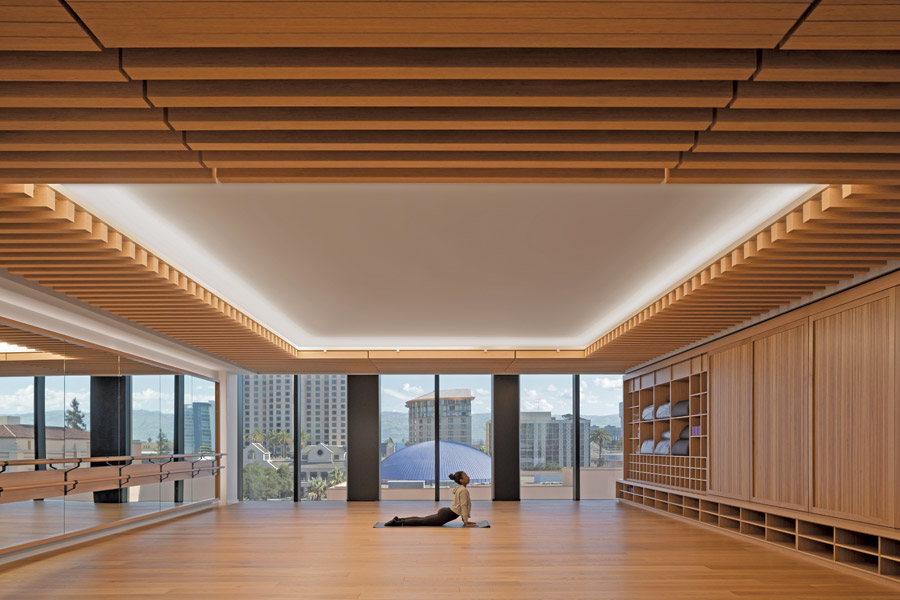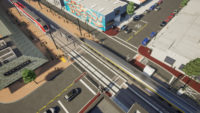Northern California Project of the Year
200 Park: Transformational Engineering Speeds Rise of San Jose Tower

Despite a COVID-related pause, work on 200 Park completed a month ahead of schedule and under budget.
Photo by Jason O’Rear
200 Park
San Jose, Calif.
BEST PROJECT, OFFICE/RETAIL/MIXED-USE
KEY PLAYERS
Submitted by: Level 10 Construction
Owner: Jay Paul Co.
Lead Design Firm: Gensler
General Contractor: Level 10 Construction
Civil Engineer: Kier & Wright Civil Engineers & Surveyors Inc.
Structural Engineer: Magnusson Klemencic Associates
MEP Engineer: Critchfield Mechanical Inc.
Electrical Engineer: Redwood Electric Group
Plumbing Engineer: ACCO Engineered Systems
Structural Steel Fabricator/Erector: Schuff Steel
The 300-ft-tall commercial office high-rise 200 Park in San Jose, Calif., is just the second tower built with the SpeedCore concrete-filled composite steel plate shear wall core system.
ENR’s Best Projects judges were impressed by the team’s ability to conduct a four-story excavation in a tight urban environment as well as crews working in parallel and their use of SpeedCore to help save time. The judges also admired the inclusion of convertible stacker parking levels and design elements such as the unique outdoor spaces on every level, with one calling it a “visually attractive building.”
Casey Kraning, director of real estate development at the owner, Jay Paul Co., agrees with the judges. He says the company “is extremely proud” of the final result.
“Having the opportunity to bring together transformational engineering methods, forward-thinking sustainability features and precinct-wide activation elements is something we are truly excited to bring to market and to downtown San Jose,” Kraning says.

The ground floor of 200 Park features 2,000 sq ft of retail space, and the first three floors above can be converted from parking into additional office space, depending on demand.
Photo by Jason O’Rear
The 19-story building, which is the tallest in San Jose, totals nearly 1.4 million sq ft. It includes four levels of underground parking, and the first three floors above the lobby are stacked parking that can be converted into more office space. Its floor plates average 54,000 sq ft, allowing for varying configurations for tenants. The design features carve-outs nicknamed “solar canyons” that allow natural daylight deeper inside the building. Each floor has three terraces on different sides of the building—totaling 26,000 sq ft—allowing for flexible work “neighborhoods” that all have access to outdoor space. The building also features 2,000 sq ft of ground level retail space and a 19,000-sq-ft fitness center for tenants.
The exterior skin is primarily made of glass and embossed stainless steel panels fabricated in Italy by Outokumpu. The window-to-wall ratio is different on each face based on the building’s orientation, so the north facade is more transparent while the south and west are more opaque. Those choices were also intended for the highest possible envelope performance, and the team says 200 Park was built to meet LEED Gold BD+C New Construction requirements as well as Fitwel certification.
Work started in January 2020 and completed a month ahead of schedule and under budget in May 2023.

The building features three terraces on each floor, totaling 26,000 sq ft. As a result, all of the flexible office spaces have access to fresh air and natural light.
Photo by Jason O’Rear
Core Options
Early in design, structural engineer Magnusson Klemencic Associates (MKA) presented three options: a traditional concrete core with gravity framing hung off, a hybrid option using a brace frame with reinforced columns and steel plating or SpeedCore following its first use on the 850-ft-tall Rainier Square Tower in Seattle.
SpeedCore uses a system of panels consisting of steel plates with cross-connecting tie rods. After being placed, the panels are filled with concrete and more panels stacked. Ron Klemencic, CEO and chair of MKA, led development of the technique.
After completing the project, Kevin Englund, vice president of operations at general contractor Level 10 Construction, says he would use the system again.
“MKA is probably one of the best engineers I’ve worked with in my career—a very sharp group.”
—Kevin Englund, Vice President of Operations, Level 10 Construction
“I was very impressed with it,” he says of SpeedCore. “I think at the end of the day, you look at all the time you take out of the field in terms of formwork, concrete placement and rebar with a traditional core. And you can put that all into a shop where it’s more controlled, generally safer with less risk of falls, and put that all into a modular system is a benefit all the way around.”
The project team established a guaranteed maximum price before the design and buy-out were completed, and Englund says costing out all the items showed savings in money and time by using SpeedCore. But, he adds, SpeedCore may not apply as well for all projects, depending on their geometries.
“It just needs to be evaluated on a case-by-case basis,” Englund says. “And MKA is probably one of the best engineers I’ve worked with in my career—a very sharp group.”
Using SpeedCore, Level 10 was able to build four floors in a week, compared with one floor every three to five days using traditional building methods. Plus, the panels were prefabricated at a shop off site, which limited onsite work and helped with safety and speed. The system also reduced core wall thickness by about 20% compared with cast-in-place concrete, resulting in more rentable space for the owner.
“By selecting that system early and designing around it, we were able to eliminate some other unknowns down the road that could have been cost risks for us,” Englund says.

With an eye on building performance and tenant well-being, 200 Park was designed to meet LEED Gold BD+C New Construction and Fitwel certification requirements.
Photo by Jason O’Rear
Being a relatively new system, the building design required third-party review by geotechnical and structural engineers for city approval. Finding a steel fabricator and contractor to work on the SpeedCore elements was no trouble; Englund says they received submissions from five or six potential subcontractors, so the novelty of SpeedCore was not an issue when assembling the team.
“By selecting [the SpeedCore] system early and designing around it, we were able to eliminate some other unknowns down the road that could have been cost risks for us.”
—Kevin Englund, Vice President of Operations, Level 10 Construction
To prepare for implementing SpeedCore, Level 10 was able to question MKA’s engineers and the contractors from the Rainier Square project about what went well and what they would have done differently (ENR 2/21-28/22 p. 22). The 200 Park team then built a full-scale mock-up of a SpeedCore unit complete with concrete grout placement to ensure they could achieve full flowable fill of the cells.
When using SpeedCore again, Englund says he would want to spend more time early on looking at the construction means and methods loads. Schuff Steel, the structural steel fabricator and erector, worked with erection stability engineer Simpson Gumpertz & Heger to develop a plan considering their material and equipment staging, hoist loads and tower crane brace points, he says. The tower crane loading required additional steel in the floor diaphragms to transfer perimeter loading to the steel core elements. The plan also included additional core stiffening via internal bracing on the connected floor levels to get the loads into the primary lateral restraining elements.
Schuff added internal lateral bracing in the SpeedCore panels for trucking to protect against deforming on the road. That helped keep them stiffer prior to being grouted and had the added benefit of providing crane pick points.
While SpeedCore helped hasten work, the project still faced challenges. Early on during cutter-soil-mix wall work for the basement in 2020, the county required a pause of work because of the COVID-19 pandemic. Two months later, Level 10 was able to resume self-performing the cast-in-place formwork with Joseph J. Albanese Inc. handling the concrete.

Carve-outs on each side of the building allow natural light to reach deep inside, while more opaque facades on the south and west sides dampen intense sunlight.
2024 California Best Projects
Challenging Excavation
The San Jose area has relatively high water tables—just 15-20 ft at 200 Park—where the team was excavating about 75 ft down. When drilling the tiebacks at the lower levels, there was a lot of water that entered the excavation that the contractor managed, treated and removed. Malcolm Drilling ensured they had standby tieback drilling equipment on site so no time would be lost while the team worked its way down the excavation due to equipment issues, Englund says. They ran two tieback rigs for most of the process to hasten the work. The team also sequenced work to minimize any nonproductive time in the excavation process. Englund says they were almost back on schedule by the time they began erecting steel.
Work completed with zero lost-time accidents, according to Level 10. Englund says the contractor has worked more than 9.5 million hours since its founding without any lost-time injuries.

The use of SpeedCore allowed crews to build four floors per week,compared with one floor every three to five days if they had used traditional building methods.
Photo by Jason O’Rear
“It’s really a core staple of the company,” he says.
The contractor held a site-specific safety orientation led by the project safety manager to review requirements and protocols with everyone working at the site. They put controls in place, such as CalOSHA-compliant rail guards, cable rails and toe boards at the opening and leading edges. And the safety manager led all-hands safety meetings and addressed safety at weekly foremen meetings throughout the project. Also, even before work begins, Englund says Level 10 is checking potential subs’ experience modification ratings as part of prequalification.
“So safety really rolls through all phases of the work, from preconstruction to procurement to the construction activities,” he says.




